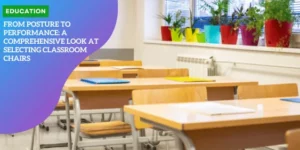Transforming Outdoor Spaces: How Shade Solutions Expand Learning Environments
Maximizing School Space
Classroom space is often at a premium in schools, posing challenges for educators and students alike.
As school populations grow, the demand for more learning areas increases.
A creative solution to this problem lies right outside—in underutilized green spaces.
These spaces present an opportunity to expand educational environments without the financial burden of new construction projects.
Utilizing Green Spaces
Green spaces are critical to school infrastructure, not just for their aesthetic value but for their practical use as well.
By transforming them into outdoor learning areas, schools can effectively increase their capacity.
Shade structures play a crucial role in this transformation, allowing for year-round use by providing protection from the elements.
This innovation not only answers the challenge of crowded classrooms but enriches the learning experience by bringing students closer to nature.
Benefits of Outdoor Learning
Moving teaching and learning outdoors doesn’t just free up indoor space.
It enhances educational experiences by offering a fresh and stimulating environment.
Students can benefit from fresh air and natural light, which are known to improve concentration and mood.
Outdoor settings can also encourage collaboration and creativity, offering a more dynamic approach to traditional classroom learning.
Creating these versatile spaces is a step forward in modern education, aligning school resources with the needs of both students and faculty.
By embracing this aerial expansion, schools set a foundation for more adaptable and inclusive learning frameworks.
Balancing Sun Safety and Outdoor Activities
Importance of Vitamin D
A splash of sunlight each day plays a key role in vitamin D production, essential for building strong bones and muscles.
But in Australia, just a few minutes can suffice, especially during sunnier days.
This delicate balance is necessary to ensure students remain healthy without risking overexposure.
Risks of Excessive Sun Exposure
Australia’s sun is unforgiving.
Without proper protection, excessive sun exposure can lead to skin damage, sunburn, and other health risks.
With skin cancer being a significant concern, schools must take these risks seriously to protect their students.
Need for Sufficient Shade
Providing sufficient shade is crucial when planning outdoor activities.
Designated shaded areas allow students to enjoy the outdoors safely, whether during class time or recess.
Thoughtfully designed shade structures offer protection from the sun, making outdoor spaces more versatile and enhancing their usability throughout the school year.
Creating a safe and engaging environment requires careful consideration of these factors, creating opportunities for learning with a blend of sunlight and shade.
This understanding paves the way for innovative outdoor solutions that maximize safety and functionality.
Versatility of Shade Structures
Adaptability in Educational Settings
Shade structures offer remarkable adaptability in educational settings, enhancing the use of green spaces for various activities.
These structures can seamlessly transition from hosting outdoor classes to accommodating school assemblies and staff areas.
The flexibility provided by shade solutions enables the transformation of underutilized outdoor areas into vibrant, multi-purpose environments.
Protection Beyond the Classroom
Beyond education, shade structures provide critical protection for storage areas, bus stops, and school gardens through water collection.
They offer shelter from harsh weather, creating safe havens that ensure students and staff can move freely and comfortably throughout the school day.
Creating Dynamic Learning Environments
The integration of shade structures facilitates dynamic outdoor learning experiences.
Features like tables, whiteboards, or projectors can be easily incorporated, allowing for interactive and engaging educational settings.
Whether it’s creating space for arts and crafts or shaded areas for sports, these versatile constructions foster an enriching learning atmosphere.
By harnessing the potential of shade solutions, schools can enhance their infrastructure and improve student well-being, paving the way for innovative and inclusive educational experiences.
Customization Options for Shade Solutions
Diverse Range of Options
Shade structures come in various sizes, colors, and materials, providing schools with the flexibility to match their specific needs.
Whether covering playgrounds or creating cozy outdoor classrooms, customization allows educators to design spaces that complement existing architecture.
Tailored for Space and Purpose
When planning, consider the size and intended use of the area.
Smaller spaces might benefit from simple shade-mesh structures, while larger areas could require engineered solutions that offer protection and aesthetic appeal.
Integration of Modern Amenities
Adding amenities such as power, lighting, and PA systems can transform a basic shaded area into a fully functional outdoor classroom.
This integration supports diverse activities — from assemblies to creative arts — in a protected, connected environment.
Ultimately, well-planned shade solutions enhance school infrastructure by expanding usable space and enriching learning experiences.
Expert Insights on Shade Structure Selection
Choosing the Right Structure
Selecting the right shade structure goes beyond aesthetics. It’s crucial to prioritize durability and engineering excellence.
Consider structures that are not only visually appealing but are also robust enough to withstand local weather conditions.
From simple shade-mesh to expansive sports court roofing, the choices are varied. Each option serves different needs—shade-mesh for cost efficiency and flexibility, and engineered structures for long-term use and architectural elegance.
Tailored Applications
Shade solutions can cater to diverse applications. For temporary setups, shade sails offer flexibility but may lack longevity.
On the other hand, permanent installations such as architectural umbrellas or fabric COLAs provide sturdiness and versatility, covering anything from playgrounds to outdoor classrooms.
The goal is to match the structure with its intended use, ensuring maximum benefit.
Considering Location and Climate
A key aspect of effective shade planning is understanding the environmental context.
For areas subject to harsh conditions, like extreme heat or heavy rainfall, opting for weather-resistant materials is critical.
Australian-made aluminum structures, known for being low-maintenance, are well-suited for such climates, ensuring longevity and safety.
By carefully selecting and planning shade structures, schools can create functional and stylish outdoor learning spaces, enhancing the educational environment and accommodating diverse activities year-round.
Safety and Functionality Considerations
Protection from Environmental Elements
When designing outdoor learning spaces, protection from environmental factors is crucial.
Shade structures play an essential role in shielding students from the sun, preventing risks like sunburn and heat stroke.
These structures also protect against areas prone to storms or falling branches.
Ensuring students’ safety in all weather conditions is a priority for maintaining a secure learning environment.
Ensuring Structural Safety
It’s vital that shade structures are engineered to prevent any hazards. Support systems should be clearly visible to minimize accidents.
If they are near sports areas, padding on support posts can enhance safety, preventing injuries during active play.
Selecting the Right Design
Choosing the appropriate design for shade structures enhances both functionality and safety. Here are some options:
- Corner Post Shelters: Ideal for general use, providing solid coverage without obstructing foot traffic.
- Cantilevered Shelters: Perfect for spaces where front posts could block movement or visibility, offering accessible, open spaces.
- Shade Sails: These are suited for large or irregular areas, providing broad coverage and enhancing aesthetic appeal.
Selecting the right design ensures these structures not only serve their purpose but do so in a safe and effective way.
Transitioning to new learning methodologies and solutions in schools requires thoughtful integration of these safety features.







